#blue flowers perennial plants
Explore tagged Tumblr posts
Text
10 Most Beautiful Blue Flowers For Your Garden
Identifying a true blue flowering plant is quite difficult, as anyone who enjoys gardening knows. Flowers of various shapes and colors can be seen in nature. Pink, yellow, white, and red are the most popular flower colors. In nature, though, blue-flowered plants exist in several species. Some blue flower plant names and care instructions are shown below. In today’s post, you will learn about 10…
#blue bell flowers#blue flowered plant#blue flowering perennial plants#blue flowering plants#blue flowers names#blue flowers perennial plants#blue plants and flowers#light blue flowers#names of blue flowers#perennial plant with blue flowers#perennial plants with blue flowers#small blue flowered plants
0 notes
Text



Plant of the Day
Sunday 11 August 2024
While exploring the island of North Ronaldsay, Orkney, I spotted this small Myosotis sp. (forget-me-not) growing between the paving surrounding the lighthouse buildings.
Jill Raggett
#myosotis#forget me not#plants#native#wildflower#wildflowers#blue flowers#horticulture#orkney#short lived perennial#biennial#North Ronaldsay
195 notes
·
View notes
Text

https://wildflower-seed.com/
#archive#archiving#web archive#california#napa valley#flowers#native flowers#california native plants#california poppy#arroyo lupine#five spot#five-spot#baby blue eyes#baby-blue-eyes#perennial flax#chinese houses#gilia#bird's eyes#california bluebell#bluebells#godetia#fiddleneck#tidy tips#beach evening primrose#lupine#flax#satin flower
11 notes
·
View notes
Photo

Traditional Landscape New York Photo of a large traditional full sun backyard formal garden in summer.
#annuals mixed with perennials#low maintenance#outdoor space#blue and pink flowers#sitting area#container plantings
1 note
·
View note
Text
Blue Marguerite
Not many flowers are as blue as blue marguerite is. Like all sorts of daisies, gazanias, ice plants and so many of the familiar flowers in the Compositae family, blue marguerite, Felicia amelloides, is endemic to South Africa. Their flowers are the colors of the flag of Sweden though, with clear blue petals around bright yellow centers. These inch wide or slightly wider flowers bloom…

View On WordPress
0 notes
Text


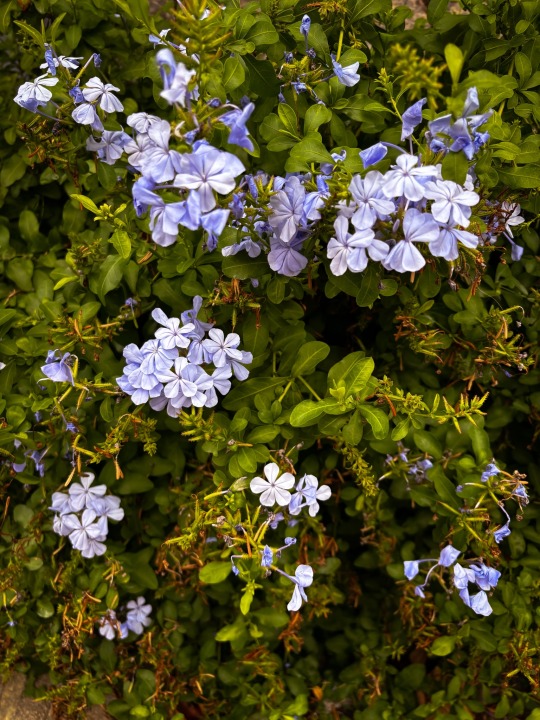
Hardy Tall Phlox Blue Paradise
The featured photo was captured and edited by me. I request that it not be copied or reproduced without my explicit permission. For any inquiries or usage requests, kindly contact me directly. Your understanding and respect for my creative work are appreciated. Thank you.
#Hardy#Tall Phlox#Blue Paradise#Perennial#Garden#Flowers#Blooms#Landscape#Horticulture#Planting#Flowerbed#Ornamental#Gardening#Botanical#Blue Flowers#Summer#Fragrance#Pollinators#Cottage Garden#Border Plant#Herbaceous#Sun-loving#Drought-tolerant#Soil#Blossoms#Foliage#Landscape Design#Flowering Perennials#Gardening Tips#Blue Flowering Plants
1 note
·
View note
Text
Thunbergia
The Thunbergia plants are prized by plant enthusiasts & gardeners for their lovely flowers & beautiful foliage. This thunbergia plant named after the Sweden Botanist Carl Peter Thunberg for his immense work in the documentation of Thunbergia plant species.
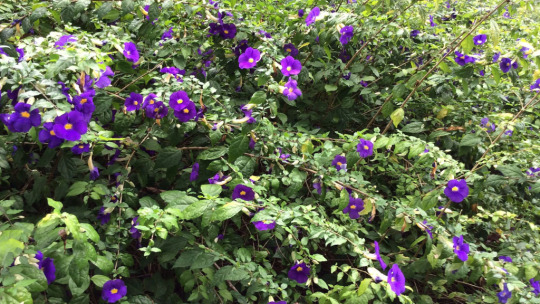
Plant Growth Habit
This plants are excellent creepers & flowering plants belongs to the Acanthaceae family with vibrant color flowers. This plant commonly named as clock vine & sky flower.

Sky Flower
The attractive sky flower plants contain 100+ plant varieties. Flower colors are blue, white, orange & yellow. This plant has a bushy & semi-climbing structure with a woody stem. Feathery flowers appear with yellow or center. In addition to this
it is fast growing plant that reaches up to a height of 6ft from the ground.
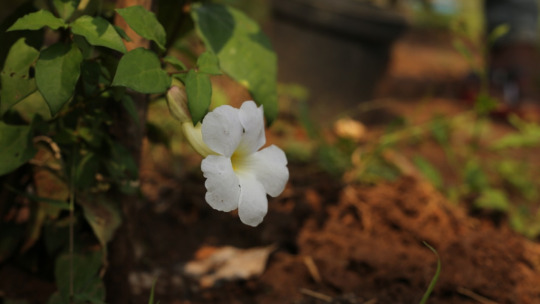
Clock Vine
The clock vine plant's popular varieties are thunbergia grandiflora, thunbergia erecta, natalensis, alata & dwarf varities.
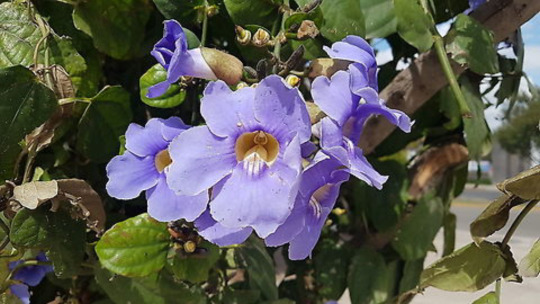
Thunbergia grandiflora
The grandiflora plants are native to India with large leaf foliage with lavender color flowers. Long roots with deep tap root system. It comes under annual plants.
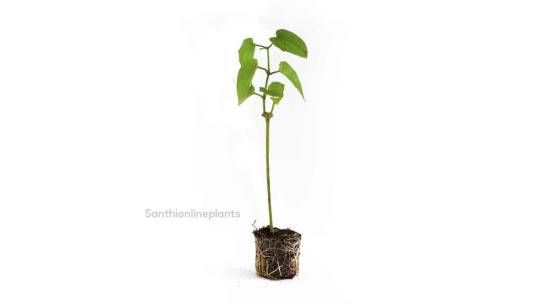

Thunbergia natalensis
It is fast growing creeper plant with white & light blue colored flowers. And the plants are native to Africa. Thunbergia natalensis has trumpet-shaped flowers that are commonly called natal blue & natal white flowers.

Thunbergia erecta
It is a twinning erect perennial shrub with ovate dark green leaves & velvety purple flowers. It is also rapidly growing creeper plants.

Soil
The Bush clock vine plant loves to grow in well-drained soil rich in organic matter. These plants tolerate a wide range of soil but avoid growing in heavy clay soils.

Benefits
These bush clock vine thunbergia plants are great for foundations, borders, beds, hedges & other landscape values.
There are no serious pest, disease & nematode issues for this creeper plant.
The Thunbergia erecta plants used in the treatment of anxiety, depression & insomnia issues.
Bush clock vine has anti-oxidant & anti-inflammatory properties.

The creeper plants grow on walls, trellises, fences, and other plants. And they are popular in gardens as they add visual interest and provide good greenery look.
There is no alternate for Green so far!
#Thunbergia grandiflora#The grandiflora plants are native to India with large leaf foliage with lavender color flowers. Long roots with deep tap root system. It co#thunbergia grandiflora#Thunbergia natalensis#It is fast growing creeper plant with white & light blue colored flowers. And the plants are native to Africa. Thunbergia natalensis has tr#thunbergia natalensis#Thunbergia erecta#It is a twinning erect perennial shrub with ovate dark green leaves & velvety purple flowers. It is also rapidly growing creeper plants.#thunbergia erecta#Soil#The Bush clock vine plant loves to grow in well-drained soil rich in organic matter. These plants tolerate a wide range of soil but avoid g#thunbergia grandiflora soil#Potting Mix- Garden soil+30-40% compost +steamed bone meal +20% of cocopeat if needed alone.#steamed bone meal for clock vine#Water Requirement#Watering the plants regularly helps to grow healthy plants means keeping the soil moist. But the sky flower plants cannot tolerate waterlog#watering for sky flower#Sunlight#The bush clock vine plant thrives well in full direct sunlight with partial shade.#clock vine#Pot Size#This creeper plant requires a pot size of 6-8'' while planting. After one of planting change the pot size to 12'' with good drainage holes.#sky flower poting#Propagation#The thunbergia varieties are easily propagated through stem cuttings. Select the non-flowering#healthy stem and make a clean cut just below a node. Gently remove the lower leaves from the plants. And place the plant cuttings in a plan#thunbergia grandiflora propagation#Pruning#Regular pruning helps to keep the plants in a compact structure.#pruning of sky flower
0 notes
Text
Thunbergia
The Thunbergia plants are prized by plant enthusiasts & gardeners for their lovely flowers & beautiful foliage. This thunbergia plant named after the Sweden Botanist Carl Peter Thunberg for his immense work in the documentation of Thunbergia plant species.

Plant Growth Habit
This plants are excellent creepers & flowering plants belongs to the Acanthaceae family with vibrant color flowers. This plant commonly named as clock vine & sky flower.
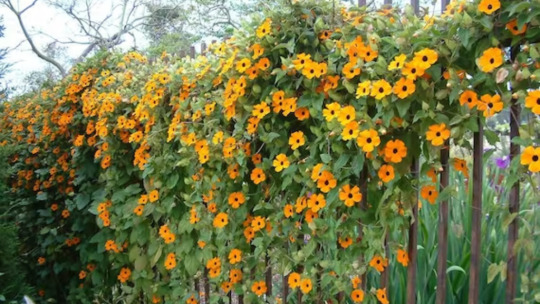
Sky Flower
The attractive sky flower plants contain 100+ plant varieties. Flower colors are blue, white, orange & yellow. This plant has a bushy & semi-climbing structure with a woody stem. Feathery flowers appear with yellow or center. In addition to this
it is fast growing plant that reaches up to a height of 6ft from the ground.

Clock Vine
The clock vine plant's popular varieties are thunbergia grandiflora, thunbergia erecta, natalensis, alata & dwarf varities.

Thunbergia grandiflora
The grandiflora plants are native to India with large leaf foliage with lavender color flowers. Long roots with deep tap root system. It comes under annual plants.
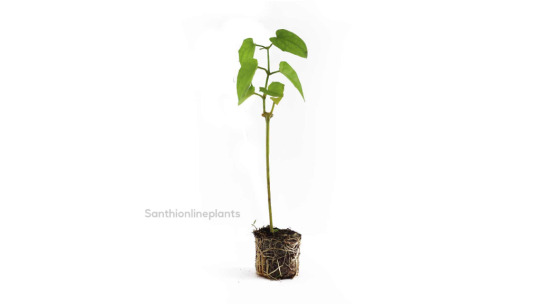
Thunbergia natalensis
It is fast growing creeper plant with white & light blue colored flowers. And the plants are native to Africa. Thunbergia natalensis has trumpet-shaped flowers that are commonly called natal blue & natal white flowers.

Thunbergia erecta
It is a twinning erect perennial shrub with ovate dark green leaves & velvety purple flowers. It is also rapidly growing creeper plants.
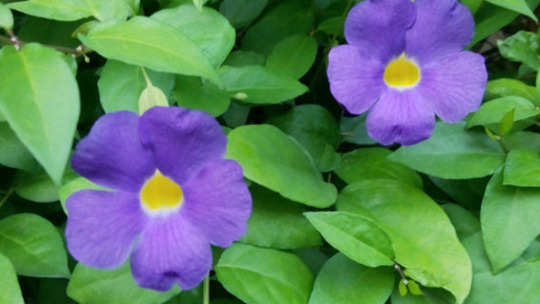
There is no alternate for Green so far!

Thunbergia creeper plants
Blog Created By: www.santhionlineplants.com
#Thunbergia natalensis#It is fast growing creeper plant with white & light blue colored flowers. And the plants are native to Africa. Thunbergia natalensis has tr#thunbergia natalensis#Thunbergia erecta#It is a twinning erect perennial shrub with ovate dark green leaves & velvety purple flowers. It is also rapidly growing creeper plants.#thunbergia erecta#Soil#The Bush clock vine plant loves to grow in well-drained soil rich in organic matter. These plants tolerate a wide range of soil but avoid g#thunbergia grandiflora soil#Potting Mix- Garden soil+30-40% compost +steamed bone meal +20% of cocopeat if needed alone.#steamed bone meal for clock vine#Water Requirement#Watering the plants regularly helps to grow healthy plants means keeping the soil moist. But the sky flower plants cannot tolerate waterlog#watering for sky flower#Sunlight#The bush clock vine plant thrives well in full direct sunlight with partial shade.#clock vine#Pot Size#This creeper plant requires a pot size of 6-8'' while planting. After one of planting change the pot size to 12'' with good drainage holes.#sky flower poting#Propagation#The thunbergia varieties are easily propagated through stem cuttings. Select the non-flowering#healthy stem and make a clean cut just below a node. Gently remove the lower leaves from the plants. And place the plant cuttings in a plan#thunbergia grandiflora propagation#Pruning#Regular pruning helps to keep the plants in a compact structure.#pruning of sky flower#Fertilizer#Application of any organic compost monthly once or twice around the plants helps to grow bushy.#compost for thunbergia
0 notes
Text
Thunbergia
The Thunbergia plants are prized by plant enthusiasts & gardeners for their lovely flowers & beautiful foliage. This thunbergia plant named after the Sweden Botanist Carl Peter Thunberg for his immense work in the documentation of Thunbergia plant species.
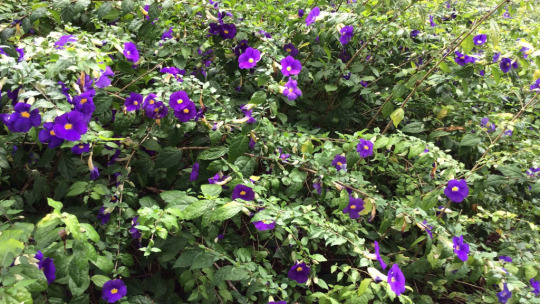
Plant Growth Habit
This plants are excellent creepers & flowering plants belongs to the Acanthaceae family with vibrant color flowers. This plant commonly named as clock vine & sky flower.
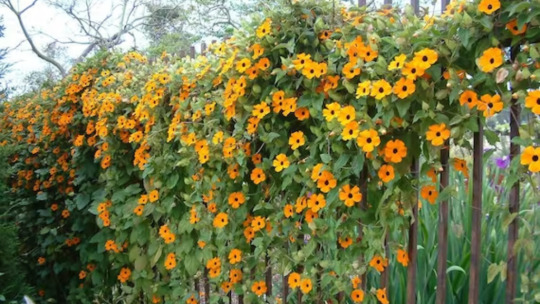
Sky Flower
The attractive sky flower plants contain 100+ plant varieties. Flower colors are blue, white, orange & yellow. This plant has a bushy & semi-climbing structure with a woody stem. Feathery flowers appear with yellow or center. In addition to this
it is fast growing plant that reaches up to a height of 6ft from the ground.
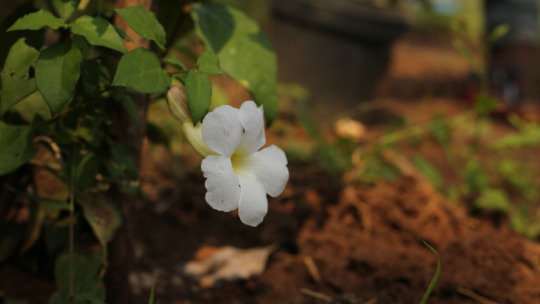
Clock Vine
The clock vine plant's popular varieties are thunbergia grandiflora, thunbergia erecta, natalensis, alata & dwarf varities.

Thunbergia grandiflora
The grandiflora plants are native to India with large leaf foliage with lavender color flowers. Long roots with deep tap root system. It comes under annual plants.
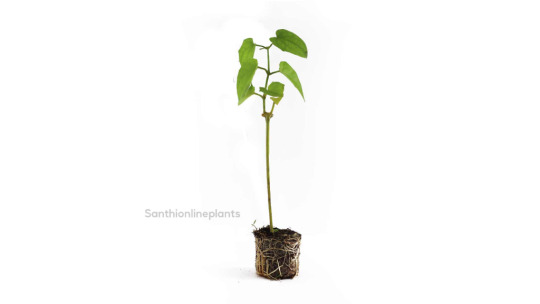
Thunbergia natalensis
It is fast growing creeper plant with white & light blue colored flowers. And the plants are native to Africa. Thunbergia natalensis has trumpet-shaped flowers that are commonly called natal blue & natal white flowers.

Thunbergia erecta
It is a twinning erect perennial shrub with ovate dark green leaves & velvety purple flowers. It is also rapidly growing creeper plants.

Soil
The Bush clock vine plant loves to grow in well-drained soil rich in organic matter. These plants tolerate a wide range of soil but avoid growing in heavy clay soils.

Thunbergia creeper plants
Blog Created By: www.santhionlineplants.com
#w. This plant has a bushy & semi-climbing structure with a woody stem. Feathery flowers appear with yellow or center. In addition to this#it is fast growing plant that reaches up to a height of 6ft from the ground.#sky flower#Clock Vine#The clock vine plant's popular varieties are thunbergia grandiflora#thunbergia erecta#natalensis#alata & dwarf varities.#clock vine#Thunbergia grandiflora#The grandiflora plants are native to India with large leaf foliage with lavender color flowers. Long roots with deep tap root system. It co#thunbergia grandiflora#Thunbergia natalensis#It is fast growing creeper plant with white & light blue colored flowers. And the plants are native to Africa. Thunbergia natalensis has tr#thunbergia natalensis#Thunbergia erecta#It is a twinning erect perennial shrub with ovate dark green leaves & velvety purple flowers. It is also rapidly growing creeper plants.#Soil#The Bush clock vine plant loves to grow in well-drained soil rich in organic matter. These plants tolerate a wide range of soil but avoid g#thunbergia grandiflora soil#Potting Mix- Garden soil+30-40% compost +steamed bone meal +20% of cocopeat if needed alone.#steamed bone meal for clock vine#Water Requirement#Watering the plants regularly helps to grow healthy plants means keeping the soil moist. But the sky flower plants cannot tolerate waterlog#watering for sky flower#Sunlight#The bush clock vine plant thrives well in full direct sunlight with partial shade.#Pot Size#This creeper plant requires a pot size of 6-8'' while planting. After one of planting change the pot size to 12'' with good drainage holes.#sky flower poting
0 notes
Photo

Container Garden in New York
#Photo of a large traditional full sun backyard formal garden in summer. low maintenance#container plantings#annuals mixed with perennials#landscape#blue and pink flowers#sitting area
0 notes
Text
Word List: Flower

beautiful words with "flower" to plant in your next poem/story
Blanketflower - gaillardia—i.e., any of a genus (Gaillardia) of American composite herbs with showy flower heads
Cuckooflower - a bitter cress (Cardamine pratensis) of Eurasia and North America; ragged robin (i.e., a perennial herb, Lychnis flos-cuculi, of the pink family cultivated for its pink flowers with narrow-lobed petals)
Dayflower - any of a genus (Commelina) of herbs of the spiderwort family having one petal smaller than the other two
Flowerage - a flowering process, state, or condition
Floweriness - of, relating to, or resembling flowers; marked by or given to rhetorical elegance
Foamflower - a spring-flowering herb (Tiarella cordifolia) of eastern North America that has white flowers with long stamens and no stem leaves; also called: false miterwort
Gillyflower - carnation (i.e., a plant of any of numerous often cultivated and usually double-flowered varieties or subspecies of an Old World pink, Dianthus caryophyllus, found in many color variations; also: a moderate red; archaic: the variable color of human flesh)
Globeflower - any of a genus (Trollius) of plants of the buttercup family usually with globose yellow or orange flowers
Nonflowering - producing no flowers; specifically: lacking a flowering stage in the life cycle
Pasqueflower - any of several anemones with palmately compound leaves and large usually white or purple early spring flowers
Passionflower - any of a genus (Passiflora) of chiefly tropical woody tendriled climbing vines or erect herbs with usually showy flowers and pulpy often edible berries
Satinflower - honesty; blue-eyed grass; common chickweed; flannelflower; a plant or flower of the genus Godetia
Strawflower - any of several plants having everlasting flowers
Twinflower - a prostrate subshrub (Linnaea borealis) of the honeysuckle family that is found in cool regions of the northern hemisphere and has fragrant usually pink flowers
Waxflower - a climbing plant (Stephanotis floribunda) of Madagascar often cultivated in the greenhouse for its fragrant white flowers; an epiphytic tree (Clusia insignis) of British Guiana; indian pipe; spotted wintergreen
If any of these words make their way into your next poem/story, please tag me, or leave a link in the replies. I would love to read them!
More: Word Lists
#word list#flowers#writeblr#dark academia#spilled ink#writers on tumblr#literature#writing prompt#poetry#poets on tumblr#light academia#lit#words#langblr#linguistics#nature#creative writing#gustave caillebotte#writing inspo#writing inspiration#writing ideas#writing reference#writing resources
179 notes
·
View notes
Text
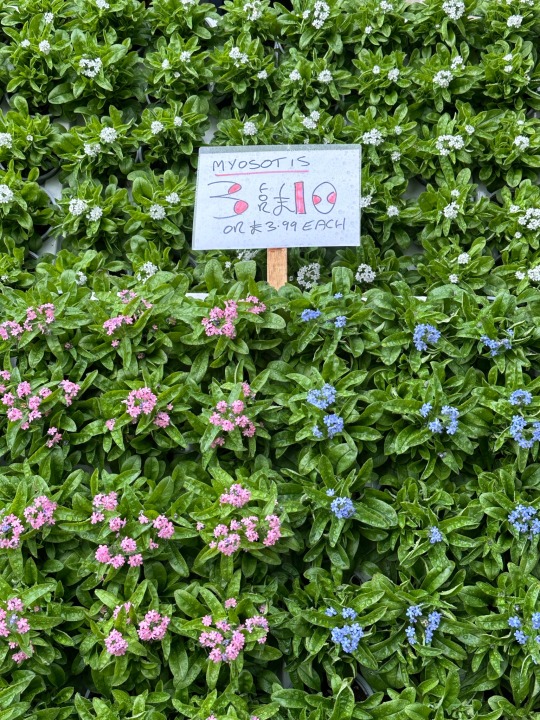

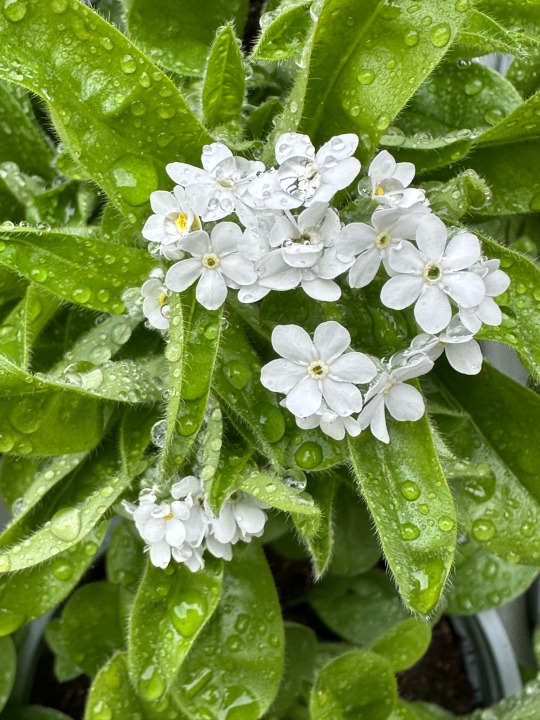

Plant of the Day
Sunday 17 March 2024
At the local market there was a display of Myosotis sylvatica cultivars (garden forget-me-not). This short-lived perennial, usually grown as a biennial, has blue flowers but the cultivars also offered white and pink flowers. These plants will have been grown from seed for spring planting in containers and borders.
Jill Raggett
#myosotis#garden forget-me-not#forget-me-not#blue flowers#white flowers#pink flowers#shortlived perennial#biennial#plants#horticulture#gardens#street market
169 notes
·
View notes
Text
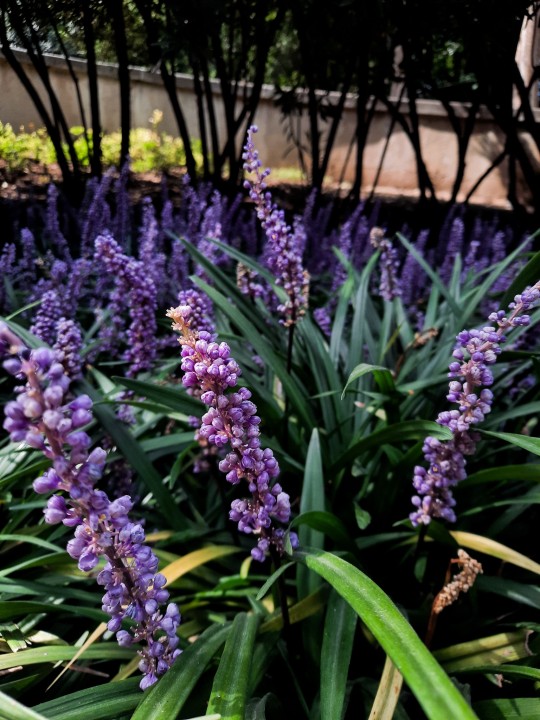


September 2024
Big blue lilyturf , lilyturf , border grass, or monkey grass (lat. Liriope muscari) — a perennial herbaceous plant. The flowers bloom in September and delight until the end of October. They also have a light, unobtrusive honey aroma🪻
Лириопа мускари (лат. Liriope muscari) — многолетнее травянистое растение. Цветки распускаются в сентябре и радуют собой до конца октября. Также они обладают лёгким, ненавязчивым медовым ароматом🪻
#noseysilverfox#photography#exotic plant#plant#botanic garden#garden#random facts#interesting#sakartvelo#nature#purple flowers#flora photography#flora fauna#flowers#autumn#nature aesthetic#naturecore#flower photography#love nature#nature photography#city#фотоблог#природа#цветы#цветение#фотографии природы#сад#интересные факты#турумбочка#растение
114 notes
·
View notes
Text



Geranium wallichianum ('Buxton's Blue')
I love this species of geranium but obviously, I'm not the only one. It seems to be pretty popular with the bumblebee community too.
As a general rule of thumb, perennial plants have short flowering seasons because they live for years and can afford to take their time. However annuals keep blooming and blooming because they have only one summer to get the job done and set seed.
The perennial Geranium wallichianum doesn't seem to be aware of that particular regulation and is well known for it's very long blooming season. Here is 'Buxton's Blue' just getting started in early June but I've posted photos of this geranium still going strong in October.
#flowers#photographers on tumblr#geranium#bumble bees#gardening#fleurs#flores#fiori#blumen#bloemen#Vancouver
163 notes
·
View notes
Text

Link Click and flowers
When CANON gives us such amazing and layered characters, we're always fascinated. We go on treasure hunts to find every little secret about them. Because we want to understand them better. We empathize with their struggles. We write meta and fanfictions.
Sometimes, CANON shares golden nuggets of easter eggs: Birthdays and flowers.
Today I'm gonna tell you everything you need to know about Myosotis and Daisies!


> Myosotis ~ Forget-Me-Not ~ Scorpion Grass
The genus name comes from the ancient Greek word, mus (mouse) and ous or otos (ear). This comes from the shape of the plant’s foliage, which features short, pointed leaves reminiscent of mouse ears. More than 70 species of myosotis exist in the world. Most likely, when you picture this flower, you think about Myosotis Alpestris. The alpine forget-me-not species is distinguished by its delicate blue petals featuring yellow throats, which create a striking contrast against the rugged landscapes where it grows. Its ability to flourish in harsh, cold environments makes it a remarkable example of nature's adaptability. Another type, Myosotis scorpiodes, is sometimes called scorpion grass, which seems like an unusual name for such a pretty little flower. Before the flowers bloom, the plant's stem appears coiled, like a scorpion’s tail. It then slowly uncurls as the flowers open up. When you give someone these tiny blooms, it represents a promise that you will always remember them and will keep them in your thoughts.
Lore
Throughout history, forget-me-nots have been laden with meaning. Europe: A German knight was strolling with his lady along the banks of the Danube river. The lady saw pretty blue flowers—but they’d been pulled loose by the river’s flow and were about to disappear downstream. She wanted to save the flowers, so her chivalrous knight jumped into the water. He couldn’t fight the strong current, so he tossed the flowers onto the bank, and as he was carried out to sea, he called out, “vergiss mein nicht”, which is German for “forget me not.” World War I, they were linked to fallen soldiers and were used as a symbol to remember the dead. Victorian era: emblematic of true love and remembrance, often given as tokens to signify faithful and enduring love. During this time period, people sent each other flowers to convey messages that couldn’t be spoken aloud. In this flower language, they represented love, devotion and everlasting faithfulness. They also conveyed the message, “Do not forget me.” Christian creation: God bestows names upon all the plants He created, except for one tiny blue flower. Afraid of being passed over, the unnamed flower calls out, “Forget me not, O Lord!” In response, God declares, “That shall be your name!”
Symbolism
Forget-me-nots represent true love, devotion, and faithfulness. Everlasting love: From the Middle Ages to Victorian era, they were used to decorate valentines. Devotion: They seen as symbols of remembrance for loved ones who have passed away. Commitment: They’re often given to spouses, significant others, or friends to convey deep affection and loyalty. Friendship: Long distance, two friends enduring affection living in different places.


> Daisy ~ Bellis Perennis ~ April Flower
Daisies originated from the Old English word "dægesēage”, meaning day's eye. This etymology reflects the flower's association with the sun and its daily cycle. It refers to the nature of the flower's sunny appearance as well as its behaviour of opening in the morning and closing at night. A sun-like core surrounded by delicate white petals as if a radiant sun is peeking through the clouds. The white, often red-tipped petals are both separate groupings of numerous flowers giving the illusion of a single flower. It actually posesses a composite flowerhead: daisies are two blossomes in a single one. Daisies are a diverse family of flowers, each carrying a unique symbolism. Bellis (meaning pretty) perennis (meaning everlasting) are the common Daisy, and those provide a message of innocence, childlike happiness and playfulness. Shasta Daisies have an ability to thrive in diverse climates, mirroring our own human resilience and making it a fitting symbol for enduring love and the continuity of life. No matter the species, it is known to bring hope and joy for anyone who takes the time to appreciate its beauty. They are often given to someone you admire. It is also a tangible expression of union, used in weddings, and ironically considered as a heartfelt farewell, placed on graves, as promise of remembrance through genuine love even in death. The birthmonth for Daisies is April.
Lore
Norse mythology: In Norse mythology, daisies were considered sacred flowers because of their power to predict the future. They represented love, loyalty, and destiny. They were also associated with Freya, the goddess of love, beauty, and fertility. According to legend, whenever Freya cried, her tears turned into daisies. Ancient Greek Mythology: According to Greek mythology, Zeus, king of the gods, fell in love with a beautiful nymph named Belides. When Hera, the wife of Zeus, learned of this, she turned Belides into a daisy to protect her from Zeus' advances. Zeus could not save Belides and instead honoured the daisy for her beauty and love. Celtic Mythology: In Celtic mythology, people associated daisies with the sun, bringing prosperity and good luck. They also believed that these bright flowers were a sign of the summer solstice, carring the sun's light to the earth. In Victorian era, they developed floriography, or the language of flowers, to relay different coded messages depending on the type of flowers they sent and received. Daisies in particular symbolized loyalty and the ability to keep secrets. Someone would send daisies to a person who told them a secret to let them know their secret was safe.
Symbolism
Daisies are quite popular for radiating cheerfulness and positivity. The beauty of this flower is that it implies trust and reciprocity. Innocence: symbolise innocence, purity, and childlike wonder, because of the flowers’ soft, white petals, which give a sense of freshness and purity. They also stand for innocence in the sense of faithful love and loyalty. Love and Romance: associated with true love and secret admirers. As two flowers which have blended harmoniously together into one bloom, it represents perfect union. Beauty: while appearing simple, their sunlike attribute makes them the symbol of aesthetics. New beginnings: for transformative times, most especially for new beginnings. Popular for spring and to welcome new chapters in life. They represent a positive change or even a fresh start. They are often used for depictions of Mary, mother of Jesus, as childbirth symbol. Friendship: tokens to express appreciation or to celebrate a beautiful bond between friends. Joy, loyalty and union in the purest sense. This one is for me haha: Celebrate a 5th anniversary
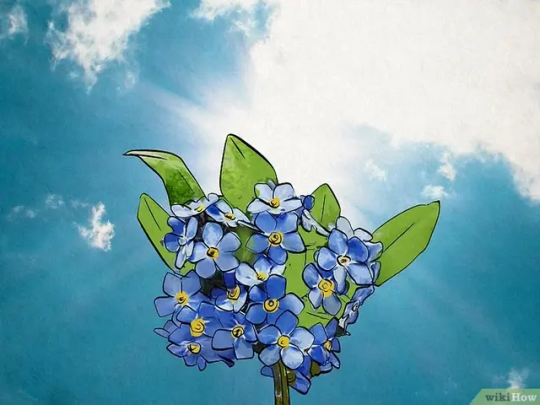
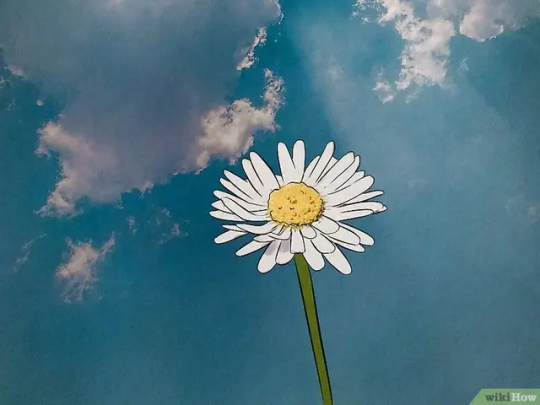
That's all for today! they choose wisely, don't you think?
I am willingly ignoring that Forget-Me-Not could hint on Lu Guang's death :D I just wanted a cute post on flowers for now.
Find out more about Hyacinth, Qiao Ling's flower, here!

49 notes
·
View notes
Text
🍠 harvesting sweet potatoes 🍠
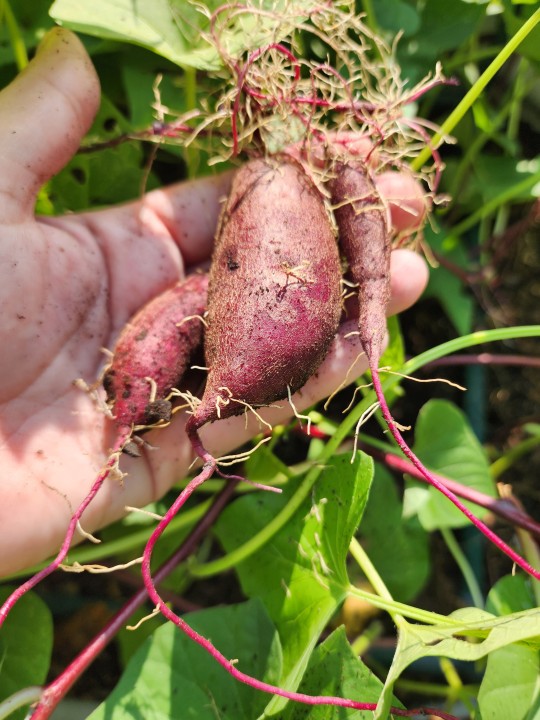
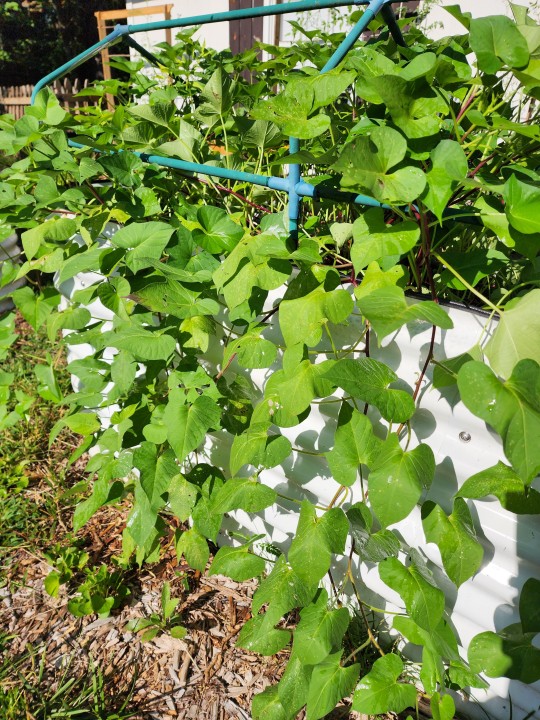
this was my second year growing potatoes, but my first year growing sweet potatoes specifically. when i grew normie potatoes, i ended up with less than what i put in the ground... that's how bad it turned out. while researching why i did so badly, i learned sweet potatoes grow totes differently so i decided i would try those this year.
i am very happy i did.
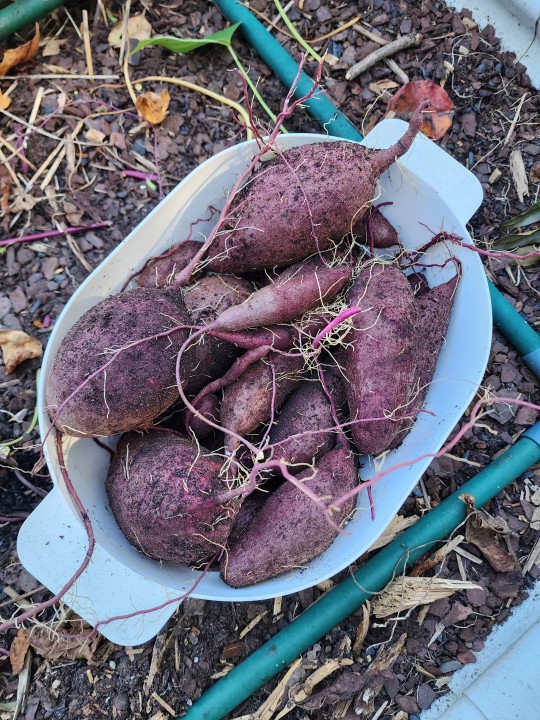
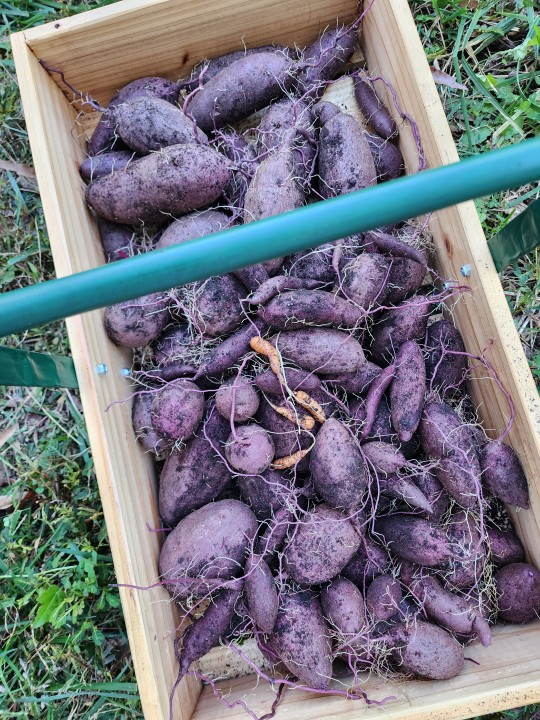
i started off by bringing my teeny tiny harvest basket assuming i did horribly, but after half of the first plant i had to go grab my big boi harvest crate my dad made me. i also found 4 baby carrots that i grew last year during my harvest. ignore those.
prior to harvesting, i turned to the internet out of habit to see what needed to be done. sadly, the internet had varying degrees of how to handle both harvesting and curing potatoes. then i remembered farmer mama used to grow these so i hit her up for the true knowledge. i shall put it here for y'all.
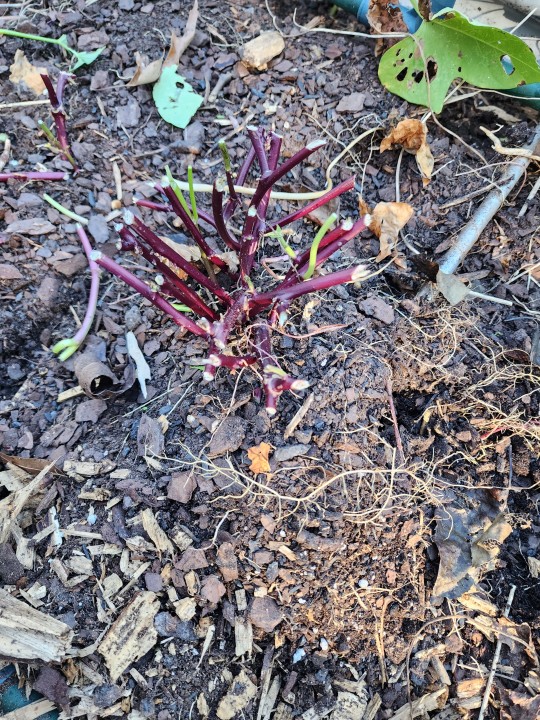

there's no need to wait until first frost, and actually it's prolly not ideal if you wait. it's going to be first frost pretty soonTM so right now is just fine. it's easier to diggie dig if you trim back all the vines first. i did prune back the vines and leaves the deer left for me, and i tossed them in as my first layer of compost for the garlic bed (garlic post soon, i'm running behind on planting them...)
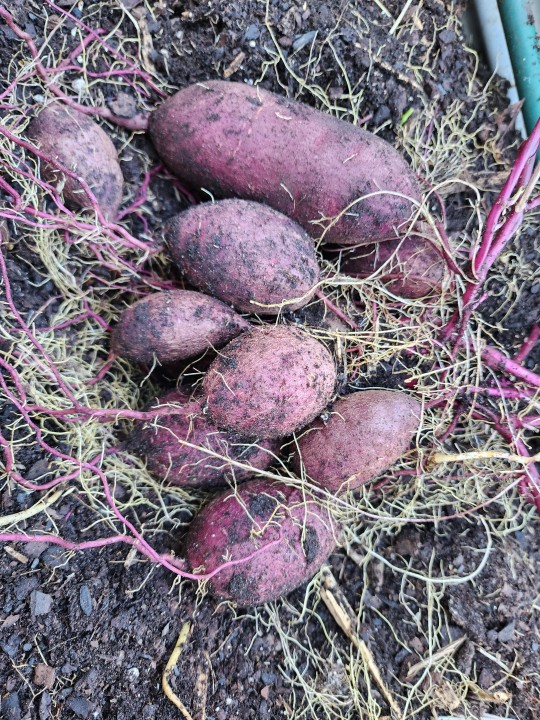
now i can grab on to the neck of the plant and rip it up. totally not morbid to phrase it that way. to say i squeed with joy when i saw large and bountiful potatoes this time is an understatement. hubs was prepping the perennial flower area to plant those plants and he thought i was getting attacked by yellowjackets again. my yipee and my panic screams are the same so i don't blame him.
for digging, since this was in my tall raised bed i just used my arms and hands and dug around. i had my shovel handy, but my acoustic self prefers to use hands for everything, and also because the shovel could pierce the skin of the potatoes. which isn't horrible, but an annoyance and an extra worry when curing so just not worth imo. the potatoes didn't go further than 8 inches below the soil, so no reason to keep digging. you can also tell when the roots get smaller and smaller. i also learned that for sweet potatoes like 90% of the taters are right under that neck, so also no real reason to dig around too much except if you want to find those baby outliers.
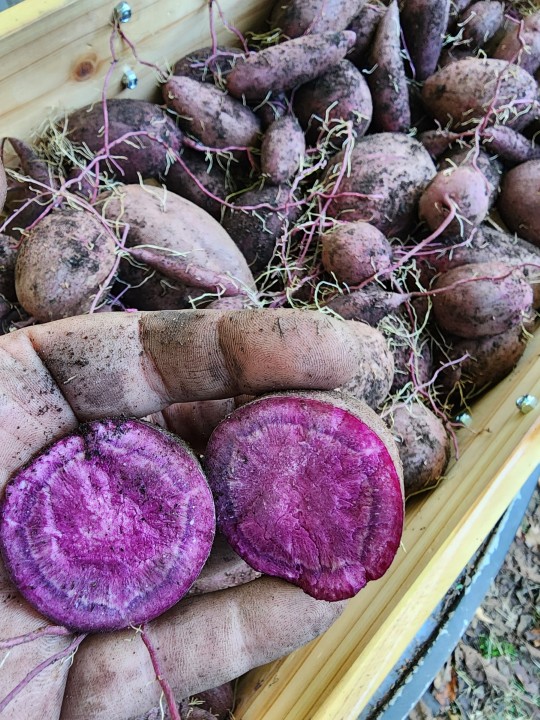
so incredibly happy with this harvest 😍❤️🍠
the purpose of me growing these was because, well, why not, but also because i want to offer sweet potato slips at the farmers market next april. i offered only a few this year because i just didn't know what would happen and if i wanted someone else to grow it and see how theirs turned out to compare. why purple? well, why normie???? purple is so much prettier and i'm actually going to focus on a lot of purple produce in 2025 lmao. but i digress.
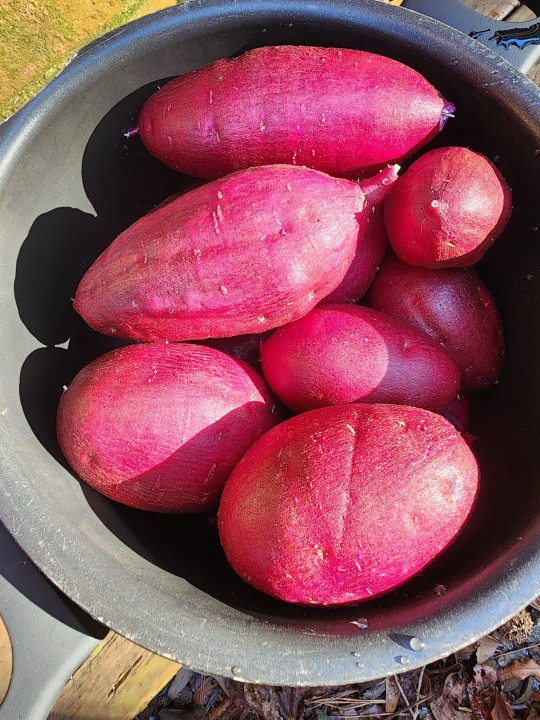
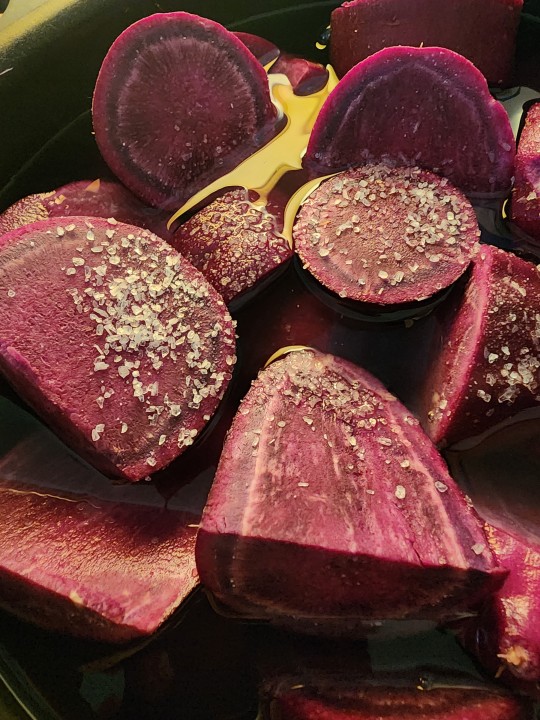
ok so i hit the tumblr photo limit just from talking about harvesting these gorgeous purple divas therefore i shall do a 2nd post about the curing stage. spoiler alert: i am curing the baby tubers because market slips next year and i washed the big chonkas in my outdoor sink and boiled them immediately.
boiling was a mistake. good news is i learned the kitchen would look pretty with purple floors 🫠 and that if you clean up purple potato water on kitchen floor with clorox bleach that it turns the purple color blue 🫠 i love science.
since i got too overexcited i boiled too much. i saved enough in the fridge to make a sweet potato pie later this week, ate some for dinner, and then froze the rest in ziploc bags. i have a feeling i'll be making multiple purple sweet potato pies this season because why the hell not.
don't worry i'll have photos of the pie when i make it. hehe.
ok chores real quick then on to the next post about curing the potatoes, very important.
#food not lawns#gardening#home garden#homegrown#gardenblr#grow food#food#homestead#nature#homesteading#garden blog#farm blog#home farm#suburbia farming#suburbian agriculture#suburban agriculture#suburban farm#potato harvest#sweet potatoes#sweet potato
27 notes
·
View notes